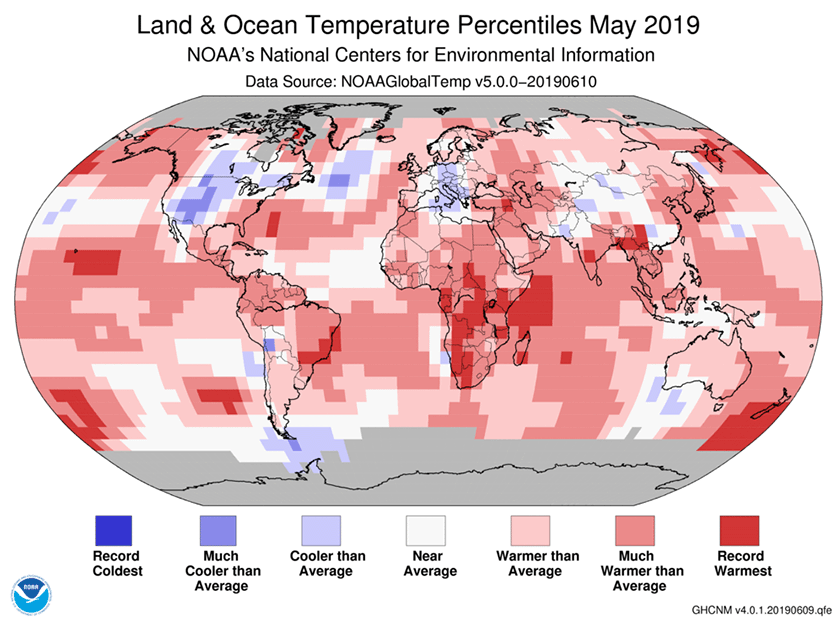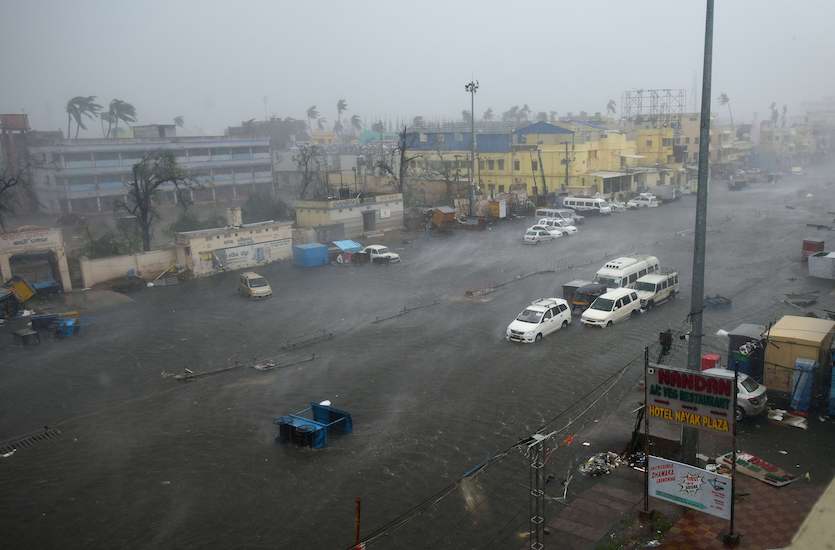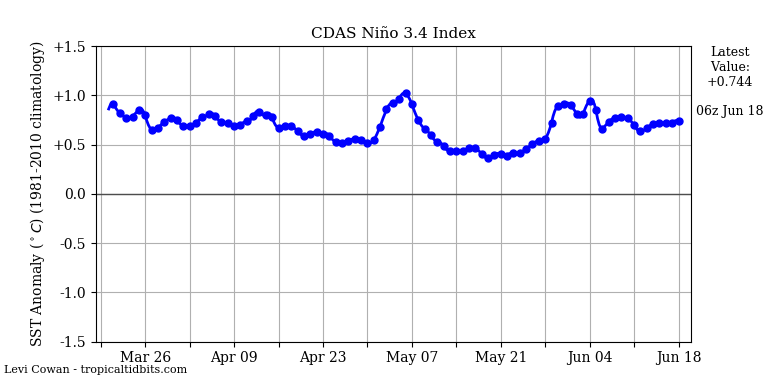| Above: Residents cope as floodwater from the Mississippi River rises on June 1, 2019 in Foley, Missouri. Multiple rounds of flooding and severe weather in the U.S. during May 2019 caused over $2 billion in damage. (Photo by Scott Olson/Getty Images). |
May 2019 was the planet's fourth warmest May since record keeping began in 1880, said NOAA's National Centers for Environmental Information (NCEI) on Tuesday. NASA rated May 2019 as tied with 2015 for third warmest May on record, behind 2016 and 2017. Minor differences in rankings between NASA and NOAA can arise because of how they handle data-sparse regions such as the Arctic, where few surface weather stations exist.
Global ocean temperatures during May 2019 were the second warmest on record, according to NOAA, and global land temperatures were the eighth warmest on record. The January through May year-to-date period had the third warmest global temperatures on record, behind 2016 and 2017. The March – May period (spring in the Northern Hemisphere and fall in the Southern Hemisphere) was the second warmest such period on record. Global satellite-measured temperatures in May 2019 for the lowest 8 km of the atmosphere were the fifth warmest in the 41-year record, according to the University of Alabama Huntsville (UAH) and RSS.
 |
| Figure 1. Departure of temperature from average for May 2019, the fourth warmest May for the globe since record keeping began in 1880, according to NOAA. Record warm May temperatures were present across much of the southern half of Africa, western Indian Ocean, parts of New Zealand and its surrounding ocean, as well as parts of Asia, South America, and the Atlantic and Pacific oceans. No land or ocean areas had record cold May temperatures. Image credit: National Centers for Environmental Information (NCEI). |
One billion-dollar weather disaster in May 2019
One billion-dollar weather-related disaster hit the Earth last month, according to the May 2019 Catastrophe Report from insurance broker Aon: Cyclone Fani in India, with at least $2 billion in damages. In addition, multiple rounds of flooding and severe weather in the U.S. caused over $2 billion in damage, though no specific 1- to 5-day event accumulated at least $1 billion in damage. It is likely that one or more of the May severe weather/flooding disasters in the U.S. will have accumulated more than $1 billion in losses by later in the year.
So far in 2019, Earth has had nine billion-dollar weather disasters:
- Flooding, Iran, 3/17 - 4/9, $8.3 billion, 77 killed
- Flooding, Midwest U.S., 3/12 - 3/28, $5 billion, 5 killed
- Flooding, Argentina, Uruguay, 1/1 - 1/20, $2.3 billion, 5 killed
- Cyclone Fani, India, Bangladesh, 5/3 – 5/5, $2 billion, 89 killed
- Cyclone Idai, Mozambiqe, Zimbabwe, Malawi, 3/3 - 3/18, $2 billion, 1007+ killed
- Flooding, Australia, 1/28 - 2/7, $1.8 billion, 3 killed
- Windstorm Eberhard, Central & Western Europe, 3/10, $1.5 billion, 2 killed
- Severe Weather, Central/Eastern U.S., 2/22 - 2/26, $1.4 billion, 4 killed
- Severe Weather, Plains, Midwest U.S., 3/23 – 3/25, $1.1 billion, 0 killed
 |
| May billion-dollar disaster 1. Tropical Cyclone Fani struck the state of Odisha in India on May 3, 2019 as a Category 4 storm with 135 mph winds, killing at least 89 people. The storm caused widespread damage in the towns of Puri, Cuttack, and the state capital of Bhubaneswar. At least 64 people died in the state before tracking into the neighboring state of West Bengal. Fani entered Bangladesh on May 4 bringing heavy rain and storm surge, resulting in 17 deaths. Total damage was expected to exceed $2 billion. Above: A view of Grand Road in Puri, India, during Tropical Cyclone Fani on Friday, May 3, 2019. Image credit: Arijit Sen/Hindustan Times via Getty Images). |
Weak El Niño event continues
On June 13, NOAA continued its El Niño Advisory, initially issued in January. “El Nino is likely to persist through the Northern Hemisphere summer 2019 (66% chance) with lower odds of continuing through the fall and winter (50-55% chance),” NOAA declared. These numbers are 4 - 5% lower than the probabilities from their May outlook.
SSTs in the Niño3.4 region—the one that’s most often used to diagnose El Niño and La Niña—must be at least 0.5°C above average for five overlapping three-month periods for an official El Niño event to be ordained. During May and the first half of June, SSTs in the Niño3.4 region were 0.5 – 0.9°C above average, within the range for a weak Niño event, and the atmospheric response was typical of what we expect to see in a weak El Niño event.
Among the latest predictions from a large number of statistical and dynamical El Niño models for the peak of the Atlantic hurricane season in August-October, about 1/3 of the models called for neutral conditions, 2/3 called for El Niño conditions, and none predicted La Niña conditions. If El Niño conditions are present this fall, this would tend to favor a slower-than-usual Atlantic hurricane season due to an increase in the upper-level winds over the tropical Atlantic that can tear storms apart (higher vertical wind shear).
 |
| Figure 2. Departure of sea surface temperatures (SSTs) in the benchmark Niño 3.4 region (in the equatorial Pacific). Since late February, SSTs have been near or above the 0.5°C above-average threshold needed for an El Niño event. Image credit: Levi Cowan, tropicaltidbits.com. |
May Arctic sea ice extent the second lowest on record
Arctic sea ice extent during May 2019 was the second lowest in the 40-year satellite record, behind the record set in May 2016, according to the National Snow and Ice Data Center (NSIDC). Fair weather, high pressure, and clear skies dominated the Arctic in May, bringing temperatures that were more than 3°C (5°F) above average over most of the Arctic Ocean. Above-average temperatures and sunshine continued into the first half of June, and between June 7 and 15, Arctic sea ice set all-time daily low extent records, surpassing the record-low years of 2012 and 2016. However, by June 16, ice extent was once more greater than that recorded in 2012 and 2016.
Antarctic sea ice extent during May 2019 was the second lowest in the 40-year satellite record, behind the record-low year of 1980.
Based on year-to-date temperatures and trends, we currently project a 75% likelihood that 2019 finishes as the second warmest year since 1850, behind only 2016. pic.twitter.com/cXRbSRFXve
— Robert Rohde (@RARohde) June 17, 2019
Based on year-to-date temperatures and trends, we currently project a 75% likelihood that 2019 finishes as the second warmest year since 1850, behind only 2016. pic.twitter.com/cXRbSRFXve
— Robert Rohde (@RARohde) June 17, 2019Notable global heat and cold marks for May 2019
Hottest temperature in the Northern Hemisphere: 50.0°C (122°F) at Jacobabad and Larkana, Pakistan, 31 May
Coldest temperature in the Northern Hemisphere: -41.5°C (-42.7°F) at Geo Summit, Greenland, 11 May
Hottest temperature in the Southern Hemisphere: 39.7°C (103.5°F) at Mandora, Australia 5 May
Coldest temperature in the Southern Hemisphere: -80.6°C (-113.1°F) at Concordia, Antarctica, 27 May
(Courtesy of Maximiliano Herrera.)
Major weather stations that set (not tied) all-time heat or cold records in May 2019
Among global stations with a period of record of at least 40 years, 63 set new all-time heat records in May and 0 set all-time cold records:
Sabang (Indonesia) max. 35.4°C, 2 May
Sawi (Thailand) max. 39.2 °C, 3 May
Guiuan (Philippines) max. 37.0 °C, 4 May and 8 May, beaten again with 37.2°C on 13 May
Sennar (Sudan) max. 47.0 °C, 5 May
Wad Medani (Sudan) max. 47.0 °C, 5 May
Kosti (Sudan) max. 46.8 °C, 5 May
Tahoua (Niger) max. 46.5 °C, 6 May
Tillabery (Niger) max. 47.5°C, 7 May
Nyaung U (Myanmar) max. 45.5°C, 8 and 10 May
Chauk (Myanmar) max. 47.1°C, 9 May
Sagaing (Myanmar) max. 43.9°C, 9 May
Gangaw (Myanmar) max. 46.6°C, 10 May
Mengla (China) max. 38.6°C, 10 May, beaten again with 38.9°C on 19 May and 40.0°C on 20 May
Juigalpa (Nicaragua) max. 39.0°C, 10 May
Falam (Myanmar) max. 33.5°C, 11 May
Pastaza (Ecuador) max. 33.4°C, 11 May
Jiangcheng (China) max. 35.7°C, 12 May, beaten again with 35.8°C on 19 May and 35.9°C on 20 May
Kedougou (Senegal) max. 44.7°C, 14 May
Pong Sa Ly (Laos) max. 35.5°C, 18,19 and 20 May
Zhanyi (China) max. 35.8°C, 18 May
Jinghong (China) max. 41.3°C, 19 May
Yuanjiang (China) max. 43.1°C, 19 May
Houei Sai (Laos) max. 41.3°C, 19 May, beaten again with 41.6°C on 20 May
Luang Namtha (Laos) max. 40.2°C, 19 May, beaten again with 40.5°C on 20 May
Oudomxay (Laos) max. 38.9°C, 19 May, beaten again with 40.8°C on 20 May
Ninh Binh (Vietnam) max. 41.3°C, 19 May
Luang Prabang (Laos) max. 42.0°C, 20 May
Chiang Rai (Thailand) max. 42.0 °C, 20 May
Kengtung (Myanmar) max. 40.5°C, 20 May
Minesat (Myanmar) max. 40.4°C, 20 May
Dien Bien (Vietnam) max. 40.0°C, 20 May
Con Cuong (Vietnam) max. 42.8°C, 20 May
Tev Aviv Airport (Israel) max. 43.6°C, 23 May
Monbetsu (Japan) max. 37.2°C,26 May
Yubetsu (Japan) max. 38.5°C, 26 May
Engaru (Japan) max. 37.7°C, 26 May
Saroma (Japan) max. 39.5°C, 26 May
Ikutahara (Japan) max. 37.0 °C,26 May
Kitami (Japan) max. 38.1°C, 26 May
Oshimizu (Japan) max. 36.7 C, 26 May
Rubeshibe (Japan) max. 36.4°C, 26 May
Sakaino (Japan) max. 37.4°C, 26 May
Mihoro (Japan) max. 37.4°C, 26 May
Nakashibetsu (Japan) max. 36.5°C, 26 May
Betsukai (Japan) max. 36.6°C, 26 May
Nemuro (Japan) max. 34.0°C, 26 May
Kawayu (Japan) max. 36.0°C, 26 May
Teshikaga (Japan) max. 35.7°C, 26 May
Akankohan (Japan) max. 35.5°C, 26 May
Rikubetsu (Japan) max. 37.8°C, 26 May
Nekubira (Japan) max. 34.5°C, 26 May
Ashoro (Japan) max. 38.8°C, 26 May
Honbetsu (Japan) max. 37.2°C, 26 May
Shikaoi (Japan) max. 36.5°C, 26 May
Meuro (Japan) max. 38.1°C, 26 May
Obihiro (Japan) max. 38.8°C, 26 May
Ikeda (Japan) max. 38.8°C, 26 May
Urahoro (Japan) max. 37.9, 26 May
Shonai (Japan) max. 38.4°C, 26 May
Kamisatsunai (Japan) max. 36.7°C, 26 May
Sarabetsu (Japan) max. 38.0°C, 26 May
Hiroo (Japan) max. 35.8°C, 26 May
Jabalpur (India) max. 46.8°C, 31 May
(Courtesy of Maximiliano Herrera.)
Five all-time national/territorial heat records set or tied in 2019
Christmas Island (Australia), 31.6°C (88.9°F), 19 January
Reunion Islands (France), 37.0°C (98.6°F), 25 January
Angola, 41.6°C (106.9°F), 22 March
Togo, 43.5°C (110.3°F), 28 March (later tied on 4 April)
Vietnam, 43.4°C, (110.1°F), 20 April
Additionally, all-time national records were probably set in Gabon, Congo, Uganda, the Ivory Coast, and possibly in Equatorial Guinea in March; possibly in the Maldives and probably in Chad, Cameroon, Gambia, Guinea, Ghana, Mali, Angola, Laos, and Guinea Bissau in April and May; and in the UAE and Haiti in June. However, persistent data outages that affected the transmission of much of the data from non-developed nations this year have prevented data from being received from a number of nations that experienced unprecedented heat waves, according to researcher Maximiliano Herrera.
No all-time national cold records have been set thus far in 2019. Most nations do not maintain official databases of extreme temperature records, so the national temperature records reported here are in many cases not official. I use as my source for international weather records researcher Maximiliano Herrera, one of the world's top climatologists, who maintains a comprehensive list of extreme temperature records for every nation in the world on his website. If you reproduce this list of extremes, please cite Maximiliano Herrera as the primary source of the weather records.
Fifty-seven monthly national/territorial heat records beaten or tied in 2019 (as of June 22)
January: Micronesia, Paraguay, Angola, Equatorial Guinea, Palau
February: Chile, Marshall Islands, Guyana, United Kingdom, Denmark, Sweden, Netherlands, Belgium, Luxembourg, Andorra, Austria, Hungary, Jersey, Guernsey, Slovakia, San Marino, Slovenia, Angola, Papua New Guinea
March: Australia, Marshall Islands, India, Kenya, Northern Marianas
April: Angola, Togo, French Southern Territories, Mayotte, Taiwan, Kenya, Mauritius
May: Kenya, Indonesia, Niger, French Southern Territories, Syria, Tonga, Laos, Vietnam, Japan, Israel, Cyprus, Turkey
June: India, Tonga, Namibia, Lithuania, Senegal, Qatar, Chile, Laos, Vietnam
Zero monthly national/territorial cold records beaten or tied in 2019 (as of June 22)
No monthly national cold records have been beaten or tied in 2019.
Hemispherical and continental temperature records in 2019
- Highest minimum temperature ever recorded in the Southern Hemisphere: 35.9°C (96.6°F) at Noona, Australia, 18 January. The record was beaten again on 26 January, with a minimum temperature of 36.6°C (97.9°F) recorded at Borrona Downs, Australia. This is also the highest minimum temperature on record for the globe for the month of January.
- Highest temperature ever recorded in the world in March: 48.1°C (118.6°F) on 10 March at Roebourne, Australia.
- Highest temperature ever recorded in Asia in March: 46.9°C (116.4°F) at Kapde, India, 25 March. The data comes from a state (not central government) station, and may not be officially recognized, but is supported by data from several nearby stations.
- Highest temperature ever recorded in the Southern Hemisphere in June: 39.8°C (103.6°F) at Walvis Bay, Namibia on 8 June.
- Highest minimum temperature ever recorded in June in the Southern Hemisphere: 28.8°C (83.8°F) at Nukunonu, Tokelau (New Zealand territory), on 12 June (ties record).



